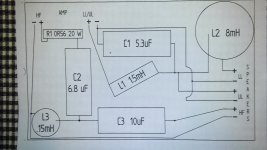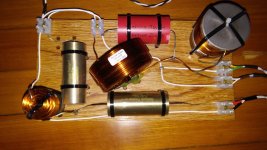I'm building outboard crossovers for speakers that originally had a R56 resistor. I have two, never used, R68 resistors. Since the difference is only 0.12 Ohms could I use the R68 resistors with no sonic problems?
Thanks,
henrylrjr
Thanks,
henrylrjr
Do these resistors feed a 25 driver line array with all connected in parallel?
One would have to see schematic of their application in order to honestly say "Dont worry....should be fine...go ahead".
One would have to see schematic of their application in order to honestly say "Dont worry....should be fine...go ahead".
What is the impedance of the tweeter? The 0.56 ohm resistor is used to trim the output of the tweeter. With a 4-ohm tweeter, the output with a 0.68 resistor is about 0.22 dB lower than the output with a 0.56 ohm. Do you think you can hear the difference? If you feel that you can hear the change in tonal balance resulting from the 0.22dB drop of the tweeter level, then you should stick with the 0.56 ohm value. Otherwise you can give the 0.68 ohm resistor a try. With an 8-ohm tweeter, the difference is even smaller.
If you parallel the 0.68 ohm resistor with a 3.2 ohm resistor, you'll get a combined resistance of ~0.56 ohm.
Kurt
If you parallel the 0.68 ohm resistor with a 3.2 ohm resistor, you'll get a combined resistance of ~0.56 ohm.
Kurt
I think, based on Kurt's reply, that "we" can honestly say "Dont worry....should be fine...go ahead" with that 0.68.
I'm trying to wrap my head around why the resistor is there in the first place. Seems unusual is all; probably put in during subjective listening tests?
I'm trying to wrap my head around why the resistor is there in the first place. Seems unusual is all; probably put in during subjective listening tests?
Hi Henry,
As Kurt and Joe say, go for it. If you think later that your tweeters are too much or too low in level, you´ll have to adjust that value anyway. And even if you then go for expensive boutique resistors, we´re not talking big $$$ here, and you have already invested money in decent quality parts.If you want to sink some money into resistors, first find your preferred value for your taste with cheap MOX resistors, than think about investments into resistors to your choice. Even with a high-quality system, differences between resistors of different quality are small.
All the best
Mattes
As Kurt and Joe say, go for it. If you think later that your tweeters are too much or too low in level, you´ll have to adjust that value anyway. And even if you then go for expensive boutique resistors, we´re not talking big $$$ here, and you have already invested money in decent quality parts.If you want to sink some money into resistors, first find your preferred value for your taste with cheap MOX resistors, than think about investments into resistors to your choice. Even with a high-quality system, differences between resistors of different quality are small.
All the best
Mattes
This is a great site and thanks for all the help. And Joe, the speakers are B&W P6 and the original XO had the R56 resistor. I built the XOs about five years ago, didn't include a resistor and the speakers sound pretty good. So now, with not much to do, I'm always looking for things to do and the old P6 XOs crossed my mind.
I'll recommend adding the 0.68 ohm resistor to see if you like the sound better. Assuming a 4 ohm tweeter is used, including a 0.56 ohm resistor would drop the tweeter output by 1.14dB, which should be noticeable. Adding the 0.68 ohm resistor would drop the tweeter level by 1.36 dB. Omitting the 0.56 ohm resistor from your crossover would make your speaker sound bright, or at least brighter than the speaker as originally designed.
Dropping the tweeter level slightly would make the frequency response more "tilted down," and this may (or may not) improve the perceived tonal balance. See, e.g., the recent review of the Carmody S2000 DIY speaker by AudioScienceReview.
Carmody S2000 DIY Speaker Kit Review | Audio Science Review (ASR) Forum
The on-axis frequency response of S2000 shows that the tweeter level might be a bit too low compared to the level of the woofer, but the lower tweeter level contributes to the speaker having a more tilted early in-room response. The reviewer actually found (subjectively, of course) the S2000 speaker to sound good.
Kurt
Dropping the tweeter level slightly would make the frequency response more "tilted down," and this may (or may not) improve the perceived tonal balance. See, e.g., the recent review of the Carmody S2000 DIY speaker by AudioScienceReview.
Carmody S2000 DIY Speaker Kit Review | Audio Science Review (ASR) Forum
The on-axis frequency response of S2000 shows that the tweeter level might be a bit too low compared to the level of the woofer, but the lower tweeter level contributes to the speaker having a more tilted early in-room response. The reviewer actually found (subjectively, of course) the S2000 speaker to sound good.
Kurt
Last edited:
Thanks for the info but after spending time searching for P6 tweeter impedance, the only info I found was on the B&W site where the P6 Spec sheet lists Nominal Impedance 8 ohms (minimum 3.5 ohms). Could the minimum 3.5 ohm be for the tweeter?
- Home
- Loudspeakers
- Multi-Way
- Resistor question

